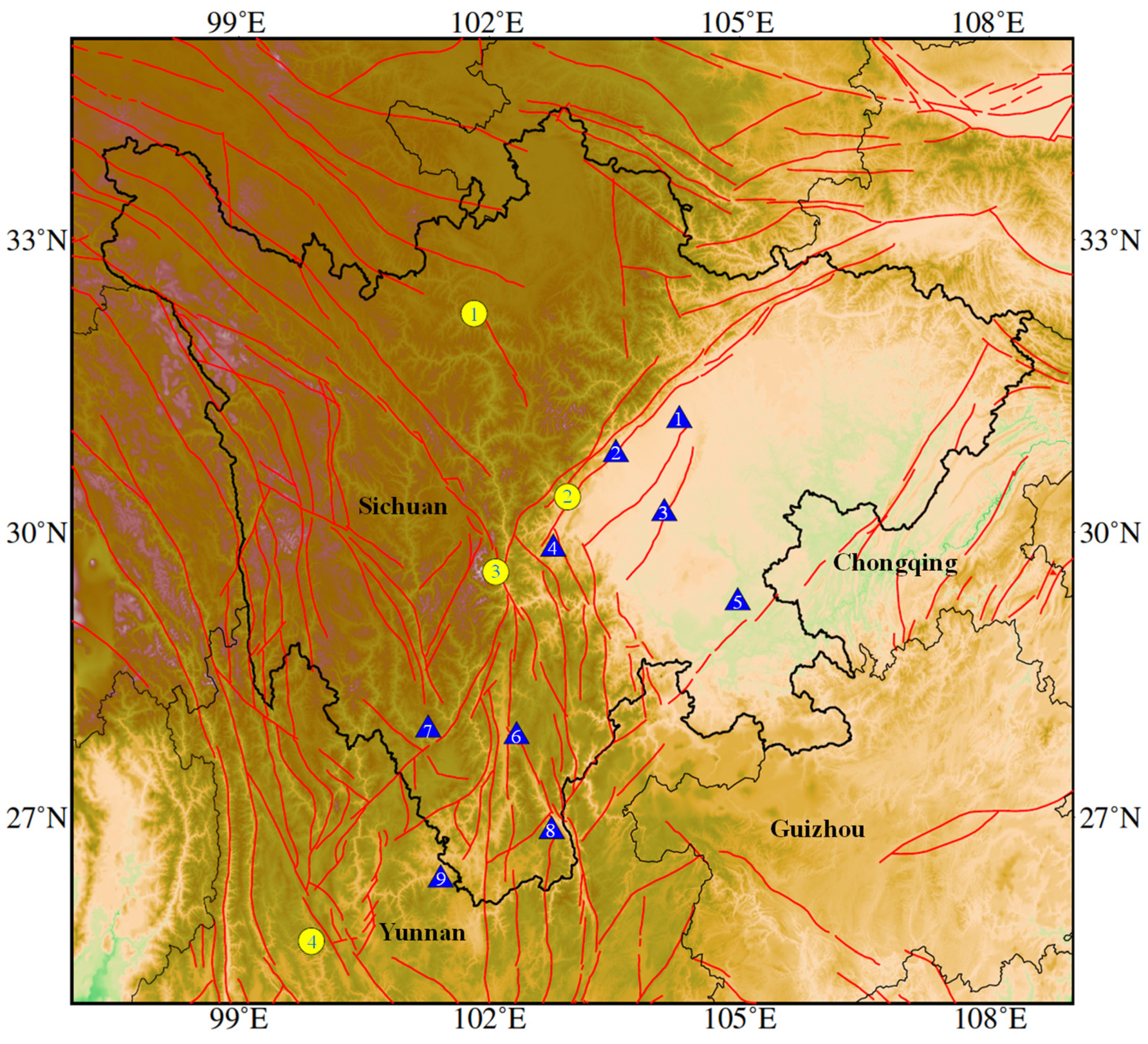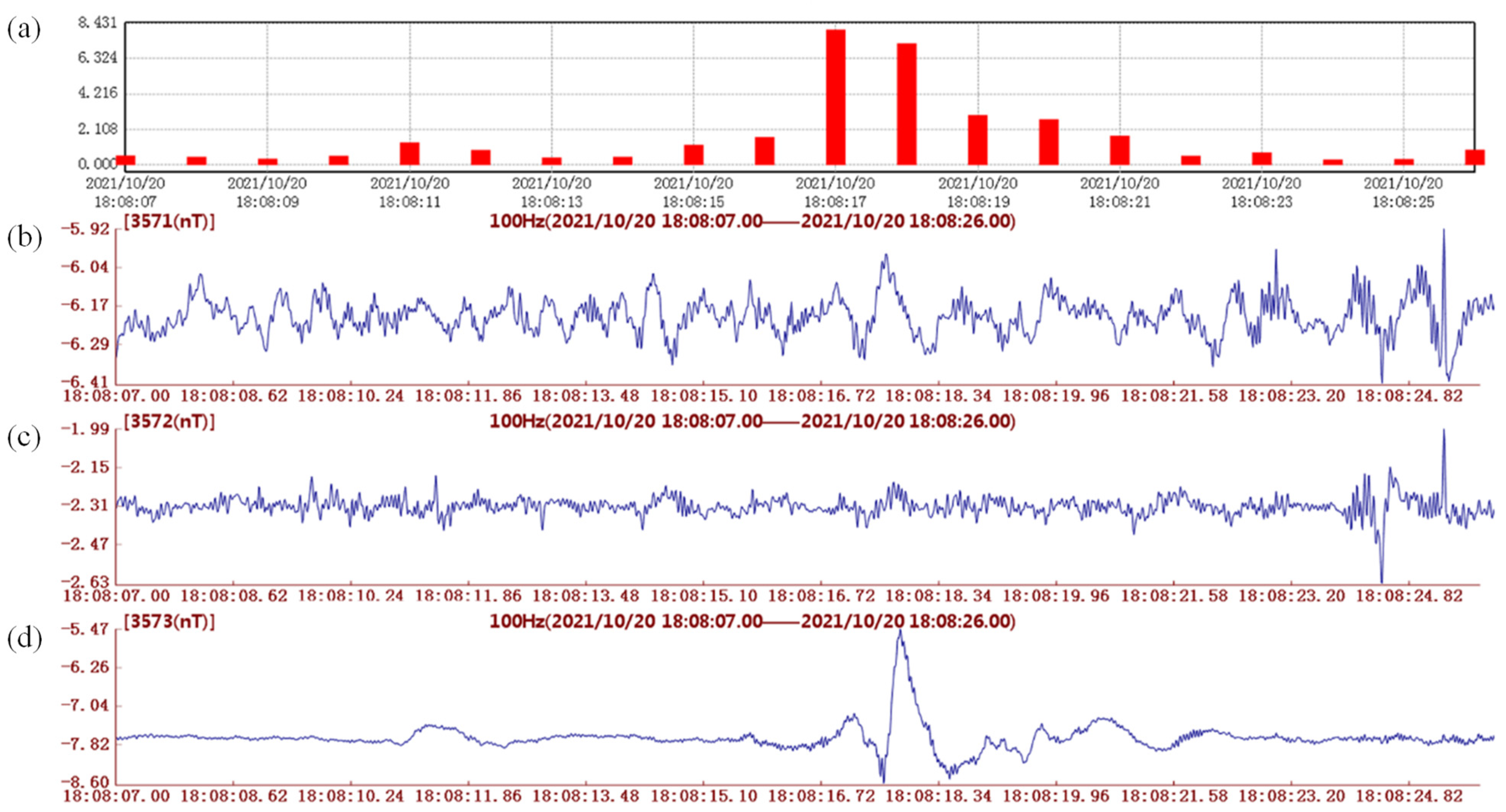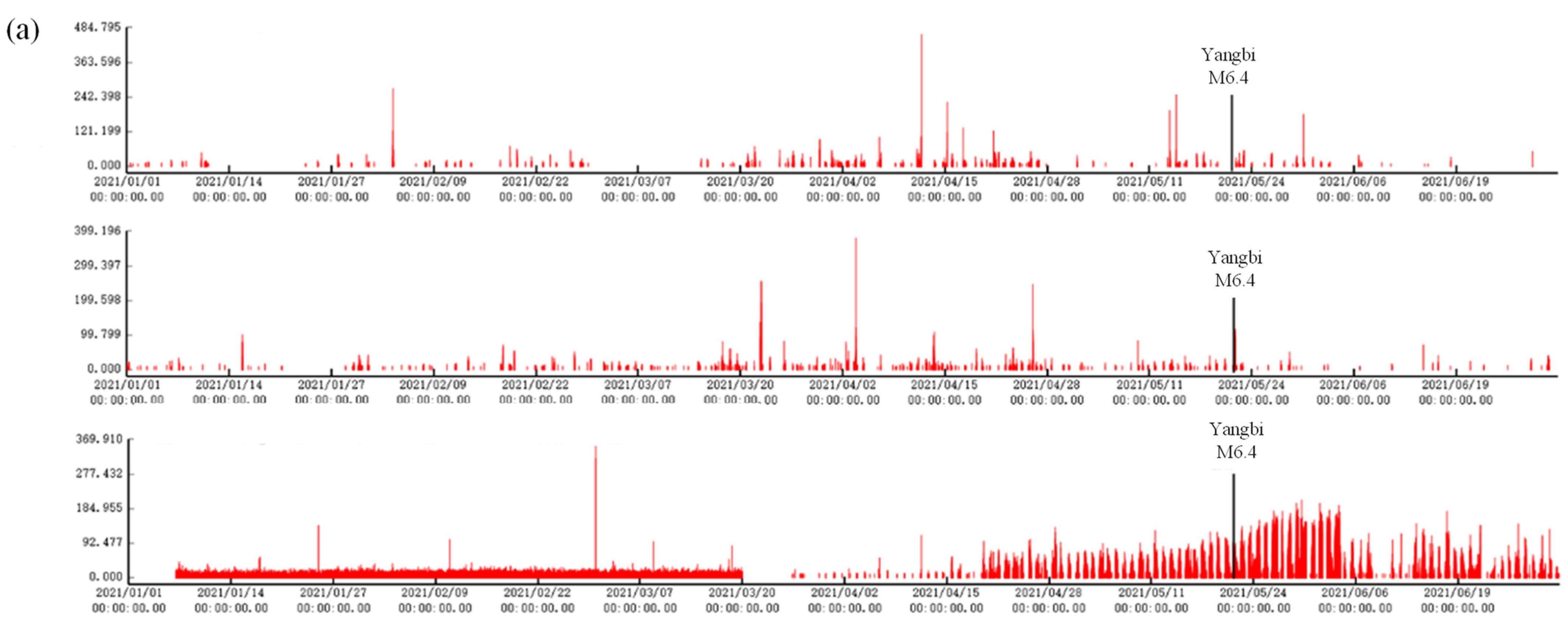Geomagnetic Disturbances and Pulse Amplitude Anomalies Preceding M > 6 Earthquakes from 2021 to 2022 in Sichuan-Yunnan, China
Abstract
1. Introduction
2. Data and Methods
2.1. Geomagnetic Observation Data from the Sichuan-Yunnan Regional Testbed Station Array
2.2. Methods
3. Results
3.1. Pre-Earthquake Geomagnetic Anomalies of the 2022 Luding M6.8 Earthquake
3.2. Pre-Earthquake Geomagnetic Anomalies of the 2021 Yangbi M6.4 Earthquake
3.3. Pre-Earthquake Geomagnetic Anomalies of the 2022 Lushan M6.1 and 2022 Malcolm M6.0 Earthquakes
4. Discussion
5. Conclusions
- (1)
- The pulse amplitude and cumulative frequency results before the 2022 Luding M6.8 earthquake show multiple synchronous anomaly characteristics, and the pulse amplitude is the highest (or higher) during this period. Similar synchronization anomalies are characterized before the 2021 Yangbi M6.4 earthquake, 2022 Lushan M6.1 earthquake, and 2022 Malcolm M6.0 earthquake; these anomalies also show a pattern of migrating toward the epicenters with time.
- (2)
- The synchronized changes are consistent with the previous understanding of magnetic anomalies, and all of these changes show the general characteristics of high pre-earthquake values and gradual recovery after the earthquake.
- (3)
- The geomagnetic vertical intensity polarization pulse amplitude method for extracting geomagnetic vertical intensity polarization anomalies is effective, and this method can be applied to short-range earthquake prediction.
Supplementary Materials
Author Contributions
Funding
Institutional Review Board Statement
Informed Consent Statement
Data Availability Statement
Acknowledgments
Conflicts of Interest
References
- Huang, Q. One possible generation mechanism of co-seismic electric signals. Proc. Jpn. Acad. 2002, 78, 173–178. [Google Scholar] [CrossRef]
- Hao, J.; Qian, S.; Gao, J.; Zhou, J.; Zhu, T. ULF electric and magnetic anomalies accompanying the cracking of rock sample. Acta Seismol. Sin. 2003, 25, 102–111. [Google Scholar] [CrossRef]
- Ren, H.; Chen, X.; Huang, Q. Numerical simulation of coseismic electromagnetic fields associated with seismic waves due to finite faulting in porous media. Geophys. J. Int. 2012, 188, 925–944. [Google Scholar] [CrossRef]
- Zhang, J.; Chen, H.; Zhang, G.; Jia, L.; Qiao, Z. Research on New Ideas of Electromagnetic Method in Earthquake Monitoring and Prediction. Chin. J. Eng. Geophys. 2014, 11, 426–430. (In Chinese) [Google Scholar]
- Akinaga, Y.; Hayakawa, M.; Liu, J.Y.; Yumoto, K.; Hattori, K. A precursory ULF signature for the Chi-Chi earthquake in Taiwan. Nat. Hazards Earth Syst. Sci. 2001, 1, 33–36. [Google Scholar] [CrossRef]
- Harada, M.; Hattori, K.; Isezaki, N. Transfer function approach to signal discrimination of ULF geomagnetic data. Phys. Chem. Earth 2004, 29, 409–417. [Google Scholar] [CrossRef]
- Yao, X.; Feng, Z. Review on the recent development of analysis methods on magnetic disturbance associated with earthquakes. Prog. Geophys. 2018, 33, 511–520. [Google Scholar]
- Hayakawa, M.; Kawate, R.; Molchanov, O.A.; Yumoto, K. Results of ultra-low-frequency magnetic field measurements during the Guam earthquake of 8 August 1993. Geophys. Res. Lett. 1996, 23, 241–244. [Google Scholar] [CrossRef]
- Feng, Z.; Li, Q.; Lu, J.; Li, H.; Qu, H.; Sun, H.; Yang, F.; Zhang, Y. The Seismic ULF Geomagnetic Reliable Information Exaction Based on Fluxgate Magnetometer Data of Second Value. South China J. Seismol. 2010, 30, 1–7. (In Chinese) [Google Scholar]
- Li, Q.; Yang, X.; Cai, S. Case Study of Applying Polarization Method to Geomagnetic Array Data. Technol. Earthq. Disaster Prev. 2015, 10, 412–417. [Google Scholar]
- He, M.; Feng, L.; Fan, W.; Zhang, G. Characteristics of geomagnetic vertical intensity polarisation values before the Jiuzhaigou 7.0 and Jinghe 6.6 earthquakes. Prog. Earthq. Sci. 2019, 8, 71–72. (In Chinese) [Google Scholar]
- Liao, X.; Feng, L.; Qi, Y.; Li, X. Application of Geomagnetic Polarization Method in the Alashan M5.0 Earthquake. Earthquake 2019, 39, 127–135. [Google Scholar]
- Li, X.; Feng, L.; Zhao, Y.; Liu, L.; Gou, Z.; Fam, W.; He, M.; Liao, X.; Yisimayili, A. Anomalous characteristics of geomagnetic vertical strength polarization before the Milin MS6.9 earthquake in 2017. Acta Seismol. Sin. 2021, 43, 584–594+678. [Google Scholar]
- Feng, L.; Guan, Y.; Fan, W.; He, M.; Li, X.; He, C.; Liao, X.; Aisa, Y.; Yuan, W.; Liu, S. Geomagnetic Vertical Component Polarization Anomaly in October 15TH 2020 before Maduo M7.4 Earthquake. Plateau Earthq. 2021, 33, 1–6. [Google Scholar]
- Feng, L.; Li, X.; Zhao, Y.; Zhang, P. A Short-term Prediction Practice on the Menyuan M6.9 Earthquake on January 8, 2022. Earthq. Res. China 2022, 38, 12–20. (In Chinese) [Google Scholar]
- Fan, W.; Feng, L.; Li, X.; He, C.; Liao, X.; Yao, X. Characteristic of geomagnetic vertical intensity polarization anomalies before the Menyuan, Qinghai Ms6.9 earthquake on January 8, 2022. China Earthq. Eng. J. 2022, 44, 744–750. (In Chinese) [Google Scholar]
- Zeng, X.P.; Zheng, J.A.; Wang, Z.Y. Large geomagnetic anomaly of impending earthquake gives a possibility in earthquake early warning. Eng. Sci. 2011, 13, 48–53. [Google Scholar]
- Kossobokov, V.G. Earthquake prediction: 20 years of global experiment. Nat. Hazards 2013, 69, 1155–1177. [Google Scholar] [CrossRef]
- Freund, F. Toward a unified solid state theory for pre-earthquake signals. Acta Geophys. 2010, 58, 719–766. [Google Scholar] [CrossRef]
- Console, R.; Pantosti, D.; D’Addezio, G. Probabilistic approach to earthquake prediction. Ann. Geophys. 2002, 45. [Google Scholar] [CrossRef]
- Grunewald, E.D.; Stein, R.S. A new 1649–1884 catalog of destructive earthquakes near Tokyo and implications for the long-term seismic process. J. Geophys. Res. Solid Earth 2006, 111, B12306. [Google Scholar] [CrossRef]
- Fraser-Smith, A.C.; Bernardi, A.; McGill, P.R.; Ladd, M.; Helliwell, R.; Villard, O.G., Jr. Low-frequency magnetic field measurements near the epicenter of the Ms 7.1 Loma Prieta earthquake. Geophys. Res. Lett. 1990, 17, 1465–1468. [Google Scholar] [CrossRef]
- Panfilov, A.A. The results of experimental studies of VLF–ULF electromagnetic emission by rock samples due to mechanical action. Nat. Hazards Earth Syst. Sci. 2014, 14, 1383–1389. [Google Scholar] [CrossRef]
- Huang, Y.; Zhu, P.; Li, S. Feasibility Study on Earthquake Prediction Based on Impending Geomagnetic Anomalies. Appl. Sci. 2023, 14, 263. [Google Scholar] [CrossRef]
- Ding, J.H.; Liu, J.; Yu, S.R.; Xiao, W.J. Geomagnetic diurnal-variation anomalies and their relation to strong earthquakes. Acta Seismol. Sin. 2004, 17, 85–93. [Google Scholar] [CrossRef]
- Xie, T.; Liu, J.; Lu, J.; Li, M.; Yao, L.; Wang, Y.; Yu, C. Retrospective analysis on electromagnetic anomalies observed by ground fixed station before the 2008 Wenchuan Ms 8.0 earthquake. Chin. J. Geophys. 2018, 61, 1922–1937. [Google Scholar]
- Hayakawa, M.; Molchanov, O.A. Seismo-electromagnetics as a new field of radiophysics: Electromagnetic phenomena associated with earthquakes. URSI Radio Sci. Bull. 2007, 2007, 8–17. [Google Scholar]
- Hayakawa, M.; Hobara, Y. Current status of seismo-electromagnetics for short-term earthquake prediction. Geomat. Nat. Hazards Risk 2010, 1, 115–155. [Google Scholar] [CrossRef]
- Zhao, G.; Bi, Y.; Wang, L.; Han, B.; Wang, X.; Xiao, Q.; Cai, J.; Zhan, Y.; Chen, X.; Tang, J.; et al. Advances in alternating electromagnetic field data processing for earthquake monitoring in China. Sci. China Earth Sci. 2015, 58, 172–182. [Google Scholar] [CrossRef]
- Zhao, G.; Zhang, X.; Cai, J.; Zhan, Y.; Ma, Q.; Tang, J.; Du, X.; Han, B.; Wang, L.; Chen, X.; et al. A review of seismo-electromagnetic research in China. Sci. China Earth Sci. 2022, 65, 1229–1246. [Google Scholar] [CrossRef]
- Eftaxias, K.; Potirakis, S.M.; Contoyiannis, Y. Four-stage model of earthquake generation in terms of fracture-induced electromagnetic emissions: A review. Complex. Seism. Time Ser. 2018, 2018, 437–502. [Google Scholar]
- Chen, H.; Han, P.; Hattori, K. Recent advances and challenges in the seismo-electromagnetic study: A brief review. Remote Sens. 2022, 14, 5893. [Google Scholar] [CrossRef]
- Uyeda, S.; Hayakawa, M.; Nagao, T.; Molchanov, O.; Hattori, K.; Orihara, Y.; Gotoh, K.; Akinaga, Y.; Tanaka, H. Electric and magnetic phenomena observed before the volcano-seismic activity in 2000 in the Izu Island Region, Japan. Proc. Natl. Acad. Sci. USA 2002, 99, 7352–7355. [Google Scholar] [CrossRef] [PubMed]
- Dunson, J.C.; Bleier, T.E.; Roth, S.; Heraud, J.; Alvarez, C.H.; Lira, A. The Pulse Azimuth effect as seen in induction coil magnetometers located in California and Peru 2007–2010, and its possible association with earthquakes. Nat. Hazards Earth Syst. Sci. 2011, 11, 2085–2105. [Google Scholar] [CrossRef]
- Hattori, K. ULF geomagnetic changes associated with large earthquakes. Terr. Atmos. Ocean. Sci. 2004, 15, 329–360. [Google Scholar] [CrossRef]
- Zhuang, J.; Vere-Jones, D.; Guan, H.; Ogata, Y.; Ma, L. Preliminary analysis of observations on the ultra-low frequency electric field in the Beijing region. Pure Appl. Geophys. 2005, 162, 1367–1396. [Google Scholar] [CrossRef]
- Schekotov, A.Y.; Molchanov, O.A.; Hayakawa, M.; Fedorov, E.N.; Chebrov, V.N.; Sinitsin, V.I.; Gordeev, E.E.; Belyaev, G.G.; Yagova, N.V. ULF/ELF magnetic field variations from atmosphere induced by seismicity. Radio Sci. 2007, 42, 1–13. [Google Scholar] [CrossRef]
- Han, P.; Hattori, K.; Hirokawa, M.; Zhuang, J.; Chen, C.H.; Febriani, F.; Yamaguchi, H.; Yoshino, C.; Liu, J.Y.; Yoshida, S. Statistical analysis of ULF seismomagnetic phenomena at Kakioka, Japan, during 2001–2010. J. Geophys. Res. Space Phys. 2014, 119, 4998–5011. [Google Scholar] [CrossRef]
- Wu, Z.; Xia, J.; Tan, B.; Wang, B.; Zhao, Q.; He, S. Detection and characterization of geomagnetic anomaly waveforms. J. Asian Earth Sci. 2024, 259, 105837. [Google Scholar] [CrossRef]
- Cummer, S.A. Modeling electromagnetic propagation in the Earth-ionosphere waveguide. IEEE Trans. Antennas Propag. 2000, 48, 1420–1429. [Google Scholar] [CrossRef]
- Shen, X.F.; Ni, B.B.; Gu, X.D.; Zhou, C.; Liu, Y.; Xiang, Z.; Zhao, Z.Y. A statistical analysis of solar wind parameters and geomagnetic indices for the Solar Cycle 23. Chin. J. Geophys. 2015, 58, 362–370. [Google Scholar]
- Kang-kun, T.; Du, A.M.; Hong, M.H. On the studies of geomagnetic ULF waves. Prog. Geophys. 2009, 24, 1550–1553. [Google Scholar]
- Xu, W.Y. Past, present, and future of geomagnetic indices. Prog. Geophys. 2009, 24, 830–841. [Google Scholar]
- Yang, D.; He, Y.; Chen, C.; Qian, J. V: A new index to represent the variation rate of geomagnetic activity. Earthq. Sci. 2010, 23, 343–348. [Google Scholar] [CrossRef][Green Version]
- Hu, X.; Zhang, S.; He, Y.; Li, X.; Wang, L.; Luo, N.; Zhu, R.; Li, J. Geomagnetic observations refer to the background noise and the relationship of season and latitude analysis. Seism. Geomagn. Obs. Res. 2012, 33, 124–129. (In Chinese) [Google Scholar]
- Bortnik, J.; Cutler, J.W.; Dunson, C.; Bleier, T.E.; McPherron, R.L. Characteristics of low-latitude Pc1 pulsations during geomagnetic storms. J. Geophys. Res. Space Phys. 2008, 113, A04201. [Google Scholar] [CrossRef]
- Bulusu, J.; Pilipenko, V.; Arora, K.; Simha, C.P. Patterns of geomagnetic Pc1 pulsations in different solar cycles in the near-equatorial region from the Indian subcontinent. J. Atmos. Sol. -Terr. Phys. 2002, 240, 105963. [Google Scholar] [CrossRef]
- Molchanov, O.A.; Hayakawa, M. Subionospheric VLF signal perturbations possibly related to earthquakes. J. Geophys. Res. Space Phys. 1998, 103, 17489–17504. [Google Scholar] [CrossRef]
- Feng, L.; Qu, R.; Ji, Y.; Zhu, W.; Zhu, Y.; Feng, Z.; Fan, W.; Guan, Y.; Xie, C. Multistationary geomagnetic vertical intensity polarization anomalies for predicting M ≥ 6 earthquakes in Qinghai, China. Appl. Sci. 2022, 12, 8888. [Google Scholar] [CrossRef]
- Hayakawa, M.; Itoh, T.; Hattori, K.; Yumoto, K. ULF electromagnetic precursors for an earthquake at Biak, Indonesia on February 17, 1996. Geophys. Res. Lett. 2000, 27, 1531–1534. [Google Scholar] [CrossRef]
- Kopytenko, Y.A. Study of local anomalies of ULF magnetic disturbances before strong earthquakes and magnetic fields induced by tsunami. Electromagn. Phenom. Assoc. Earthq. 2009, 2009, 21–40. [Google Scholar]
- Molchanov, O.; Schekotov, A.; Fedorov, E.; Belyaev, G.; Gordeev, E. Preseismic ULF electromagnetic effect from observation at Kamchatka. Nat. Hazards Earth Syst. Sci. 2003, 3, 203–209. [Google Scholar] [CrossRef]
- Smirnova, N.A.; Hayakawa, M. Fractal characteristics of the ground-observed ULF emissions in relation to geomagnetic and seismic activities. J. Atmos. Sol. -Terr. Phys. 2007, 69, 1833–1841. [Google Scholar] [CrossRef]
- Schekotov, A.; Fedorov, E.; Hobara, Y.; Hayakawa, M. ULF magnetic field depression as a possible precursor to the 2011/3.11 Japan earthquake. J. Atmos. Electr. 2013, 33, 41–51. [Google Scholar] [CrossRef]
- He, C.; Feng, Z. Application of polarization method to geomagnetic data from the station Chengdu. Acta Seismol. Sin. 2017, 39, 558–564. [Google Scholar]
- Liu, S.Z.; Qin, Z.M.; Zhang, L.E. Dynamic Variation Characteristics Analysis of Geomagnetic ULF in Taiyuan Station by polarization method. Shanxi Earthq. 2017, 4, 5–7. (In Chinese) [Google Scholar]
- Li, X.; Feng, L.L.; Feng, Z.S.; Zhao, Y.H.; Liu, L. The characteristics of ULF magnetic field in Qinghai were analyzed by polarization method. Int. Seism. Dyn. 2019, 8, 69–70. (In Chinese) [Google Scholar]
- Liao, X.F.; Fan, W.J.; Qiu, G.L.; Li, X.H.; Yang, P. Analysis on Short Term Characteristics of Geomagnetic Vertical Intensity Polarization Anomaly before Jiuzhaigou 7.0 Earthquake on August 8 2017. Earthquake 2021, 41, 68–77. [Google Scholar]
- Hobara, Y.; Koons, H.C.; Roeder, J.L.; Yumoto, K.; Hayakawa, M. Characteristics of ULF magnetic anomaly before earthquakes. Phys. Chem. Earth 2004, 29, 437–444. [Google Scholar] [CrossRef]
- He, Y.; Zhao, X.; Yang, D.; Xia, Z. The reference background noise index of Geomagnetic Network of China and its application. Seism. Geomagn. Obs. Res. 2019, 40, 65–73. [Google Scholar]
- Ismaguilov, V.S.; Kopytenko, Y.A.; Hattori, K.; Voronov, P.M.; Molchanov, O.A.; Hayakawa, M. ULF magnetic emissions connected with under sea bottom earthquakes. Nat. Hazards Earth Syst. Sci. 2001, 1, 23–31. [Google Scholar] [CrossRef]
- Prattes, G.; Schwingenschuh, K.; Eichelberger, H.U.; Magnes, W.; Boudjada, M.; Stachel, M.; Vellante, M.; Wesztergom, V.; Nenovski, P. Multi-point ground-based ULF magnetic field observations in Europe during seismic active periods in 2004 and 2005. Nat. Hazards Earth Syst. Sci. 2008, 8, 501–507. [Google Scholar] [CrossRef]
- Yao, X.Y.; Teng, Y.T. Variation of geomagnetic polarization value associated with the 2010 Yuanmou Ms 5.2 earthquake. J. Seismol. Res. 2017, 40, 444–448. [Google Scholar]
- Li, X.; Feng, L.; Zhao, Y.; Liu, L.; Gou, Z.; Dai, M. Analysis on characteristics of geomagnetic load-unload response ratio method before Maduo Ms 7.4 earthquake. Prog. Geophys. 2022, 37, 964–970. [Google Scholar]






| Number | Station | GVIP Pulse Amplitude Threshold | Threshold of Cumulative Frequency of Anomaly (/day) | Duration Threshold (day) |
|---|---|---|---|---|
| 1 | Deyang | 10 | 70 | 10 |
| 2 | Chongzhou | 10 | 70 | 10 |
| 3 | Renshou | 10 | 210 | 10 |
| 4 | Xingjing | 10 | 210 | 10 |
| 5 | Fushun | 10 | 210 | 10 |
| 6 | Xichang | 10 | 210 | 10 |
| 7 | Muli | 10 | 210 | 10 |
| 8 | Shimenkan | 10 | 210 | 10 |
| 9 | Nanshan | 10 | 210 | 10 |
| Station Name | Epicentral Distance (km) | Anomaly Start Time | Time Interval (day) | Threshold | Cumulative Frequency (/day) | Duration (day) |
|---|---|---|---|---|---|---|
| Xichang | 204 | 6 July 2022 | 61 | 10 | 210 | 10 |
| Xingjing | 69 | 8 July 2022 | 59 | 10 | 210 | 10 |
| Deyang | 286 | 21 August 2022 | 15 | 10 | 70 | 10 |
| Station Name | Epicentral Distance (km) | Anomaly Start Time | Time Interval (day) | Threshold | Cumulative Frequency (/day) | Duration (day) |
|---|---|---|---|---|---|---|
| Xichang | 346 | 29 March 2021 | 53 | 10 | 210 | 10 |
| Muli | 284 | 19 March 2021 | 63 | 10 | 210 | 10 |
| Nanshan | 202 | 20 April 2021 | 31 | 10 | 210 | 10 |
| Earthquake | Station Name | Epicentral Distance (km) | Anomaly Start Time | Time Interval (day) | Threshold | Cumulative Frequency | Duration (day) |
|---|---|---|---|---|---|---|---|
| Lushan earthquake | Xichang | 318/478 | 21 January 2022 | 131 | 10 | 30 | 10 |
| Malcolm earthquake | Fushun | 232/420 | 17 February 2022 | 104 | 10 | 30 | 10 |
Disclaimer/Publisher’s Note: The statements, opinions and data contained in all publications are solely those of the individual author(s) and contributor(s) and not of MDPI and/or the editor(s). MDPI and/or the editor(s) disclaim responsibility for any injury to people or property resulting from any ideas, methods, instructions or products referred to in the content. |
© 2024 by the authors. Licensee MDPI, Basel, Switzerland. This article is an open access article distributed under the terms and conditions of the Creative Commons Attribution (CC BY) license (https://creativecommons.org/licenses/by/4.0/).
Share and Cite
Li, X.; Qu, R.; Ji, Y.; Feng, L.; Zhu, W.; Zhu, Y.; Liao, X.; He, M.; Feng, Z.; Fan, W.; et al. Geomagnetic Disturbances and Pulse Amplitude Anomalies Preceding M > 6 Earthquakes from 2021 to 2022 in Sichuan-Yunnan, China. Sensors 2024, 24, 4280. https://doi.org/10.3390/s24134280
Li X, Qu R, Ji Y, Feng L, Zhu W, Zhu Y, Liao X, He M, Feng Z, Fan W, et al. Geomagnetic Disturbances and Pulse Amplitude Anomalies Preceding M > 6 Earthquakes from 2021 to 2022 in Sichuan-Yunnan, China. Sensors. 2024; 24(13):4280. https://doi.org/10.3390/s24134280
Chicago/Turabian StyleLi, Xia, Rui Qu, Yingfeng Ji, Lili Feng, Weiling Zhu, Ye Zhu, Xiaofeng Liao, Manqiu He, Zhisheng Feng, Wenjie Fan, and et al. 2024. "Geomagnetic Disturbances and Pulse Amplitude Anomalies Preceding M > 6 Earthquakes from 2021 to 2022 in Sichuan-Yunnan, China" Sensors 24, no. 13: 4280. https://doi.org/10.3390/s24134280
APA StyleLi, X., Qu, R., Ji, Y., Feng, L., Zhu, W., Zhu, Y., Liao, X., He, M., Feng, Z., Fan, W., He, C., Wang, W., & Faheem, H. (2024). Geomagnetic Disturbances and Pulse Amplitude Anomalies Preceding M > 6 Earthquakes from 2021 to 2022 in Sichuan-Yunnan, China. Sensors, 24(13), 4280. https://doi.org/10.3390/s24134280







